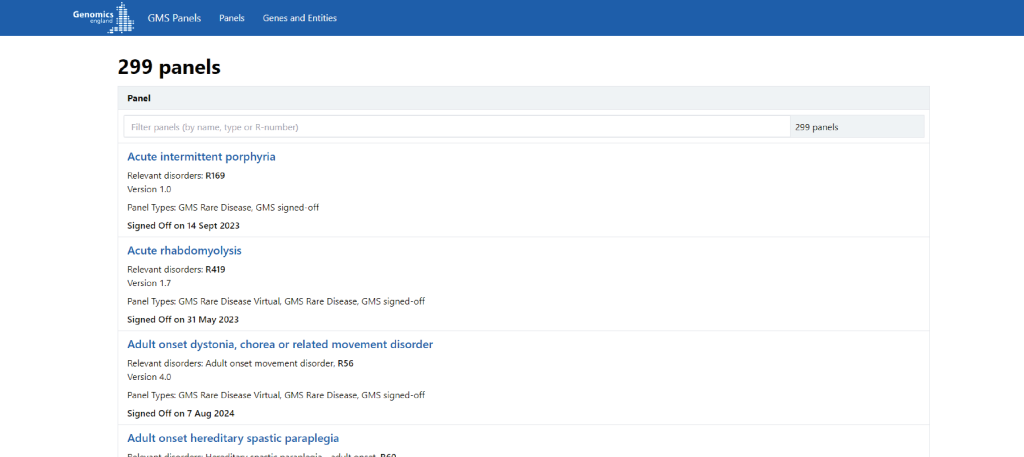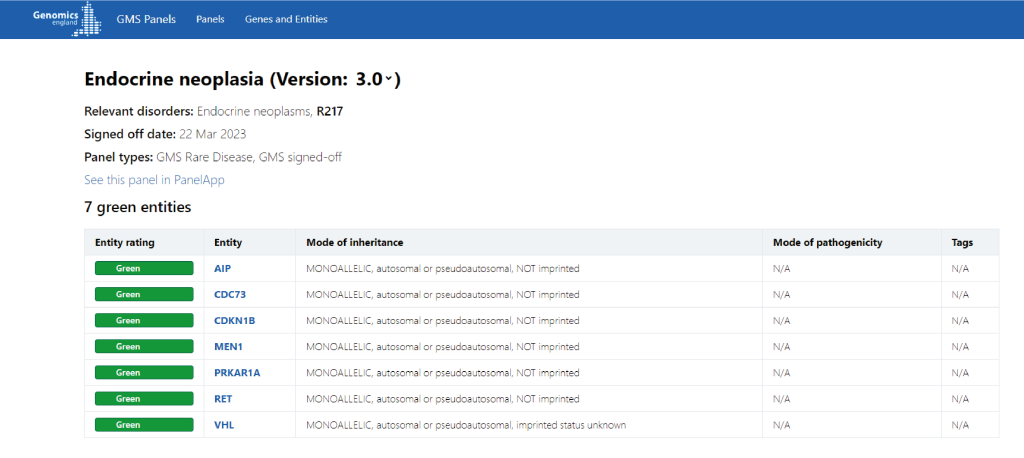NHS Genomic Medicine Service Signed Off Panels Resource
The NHS Genomic Medicine Service Signed Off Panels Resource, hosted by Genomics England, is a searchable online resource that provides more information about the gene panel tests listed in the NHS National Genomic Test Directory.
Overview
The NHS Genomic Medicine Service (GMS) Signed Off Panels Resource can be used to find out which genes are included in each gene panel listed in the National Genomic Test Directory, and is searchable by various categories.
What can the resource be used for?
Using the resource, you can:
- browse the approved/signed-off panels in use in the NHS GMS;
- find out which panel(s) a gene is on; and
- find out which genes are included in a panel associated with a particular clinical indication.
The resource can be searched and filtered by panel name, type or clinical indication code (R number) (figure 1). It is also searchable by gene, which can be useful when a particular gene has suspected involvement in a patient’s phenotype. The gene list can be filtered to show genes, short tandem repeats (STRs) or chromosomal regions. Searching by gene/genomic entity will pull up a list of all the panels in which it is included.

Figure 1: Entries in the NHS GMS Signed Off Panels Resource database. The search box allows filtering of panels by name, type or R number.
(View larger size)
After you have selected a panel, the resource displays a list of the genes/genomic entities that are included in the panel, i.e. those with a ‘green’ entity rating, which indicates that there is sufficient evidence linking them with the clinical presentation for which the panel is recommended (figure 2). Only those with a green entity rating are included; amber- and red-rated genes, which have a suspected link to the clinical indication but insufficient evidence at present to warrant their inclusion in diagnostic panels, can be viewed in PanelApp.

Figure 2: The results page for endocrine neoplasia, including a list of associated entities and their modes of inheritance.
(View larger size)
How do we use panels?
Unless specified otherwise, the genomic tests listed in the test directory will analyse the DNA code of the genes included in the panel, to look for changes that may affect function. Some panels may also include analysis of other genomic entities such as:
- short tandem repeats (STRs), in which scientists look at a repetitive region in a gene to see if it has expanded into a disease-causing range (such as in triplet repeat disorders); and
- copy number variants (CNVs), in which scientists look for a particular gain or loss of a section of genetic material.
How are panels updated
There is a regular evaluation process where the list of green-rated entities for each test is reviewed and updated. Note that a gene may be a green entity for one clinical indication but not for another, depending on the level of research evidence available to link the gene to each phenotype.
Key messages
- The NHS GMS Signed Off Panels Resource provides a database of all the clinical diagnostic panels available through the NHS GMS (Genomic Medicine Service) and the genes included in each panel.
- The database is searchable by panel or by gene, allowing you to check which genes are included in a clinical diagnostic panel, and/or which panel(s) a particular gene is included in.
- Only genes/other entities (STRs and CNVs) with a diagnostic level of evidence linking them to a particular clinical indication (‘green’) are included in a signed off NHS GMS panel.
Resources
For clinicians
-
- Genomics England: NHS GMS signed off panel resource
- Genomics England: PanelApp
- NHS England: National Genomic Test Directory
- NHS England Genomics Education Programme (GEP): Genomics in the NHS: A Clinician’s Guide to Genomic Testing in Rare Disease